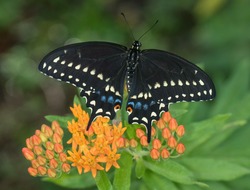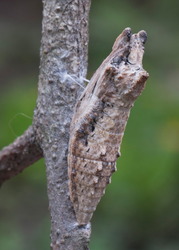Black Swallowtail Papilio polyxenes
Butterfly: Wingspan: 2½ - 3½ inches (6.7 - 8.9 cm) UPPER SURFACE (dorsal) Black. Two rows yellow or creamy spots cross fore- and hindwing. Male upper row much heavier. Male with blue on hindwing; females with wide swath of blue. Orange-red eyespot with a center black “pupil” at hindwing corner. UNDER SURFACE (ventral) Dark. Two concentric orange spot bands enclose blue cloud: female with more extensive blue. Body dark with yellow dots.
ID Tip: To separate from other large dark swallowtails, look for a dark body with a double row of creamy yellow dots. On both upper and under wing surfaces, look for an orange-red eyespot with a center black “pupil.” These are located at corner of the hindwings.
Egg: Round, yellow green. Deposited singly, often on tip of host plant leaf.
Caterpillar: Young caterpillars dark brown with white “saddle"; resemble bird droppings. Older larvae bright green with black dashes and yellow dots that form bands on each body segment. Occasionally predominately black. Osmeteria yellow orange.
Chrysalis: Mottled brown or gray; or green with yellow highlights. Color depends on season and surface texture. The overwintering stage.












5.jpg)
5.jpg)
4.jpg)































-copy-copy.jpg)





